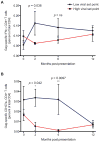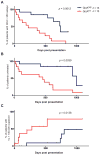HIV-specific cytolytic CD4 T cell responses during acute HIV infection predict disease outcome
- PMID: 22378925
- PMCID: PMC3918726
- DOI: 10.1126/scitranslmed.3003165
HIV-specific cytolytic CD4 T cell responses during acute HIV infection predict disease outcome
Abstract
Early immunological events during acute HIV infection are thought to fundamentally influence long-term disease outcome. Whereas the contribution of HIV-specific CD8 T cell responses to early viral control is well established, the role of HIV-specific CD4 T cell responses in the control of viral replication after acute infection is unknown. A growing body of evidence suggests that CD4 T cells-besides their helper function-have the capacity to directly recognize and kill virally infected cells. In a longitudinal study of a cohort of individuals acutely infected with HIV, we observed that subjects able to spontaneously control HIV replication in the absence of antiretroviral therapy showed a significant expansion of HIV-specific CD4 T cell responses-but not CD8 T cell responses-compared to subjects who progressed to a high viral set point (P = 0.038). Markedly, this expansion occurred before differences in viral load or CD4 T cell count and was characterized by robust cytolytic activity and expression of a distinct profile of perforin and granzymes at the earliest time point. Kaplan-Meier analysis revealed that the emergence of granzyme A(+) HIV-specific CD4 T cell responses at baseline was highly predictive of slower disease progression and clinical outcome (average days to CD4 T cell count <350/μl was 575 versus 306, P = 0.001). These data demonstrate that HIV-specific CD4 T cell responses can be used during the earliest phase of HIV infection as an immunological predictor of subsequent viral set point and disease outcome. Moreover, these data suggest that expansion of granzyme A(+) HIV-specific cytolytic CD4 T cell responses early during acute HIV infection contributes substantially to the control of viral replication.
Conflict of interest statement
Figures





Comment in
-
CD4+ T cells and HIV: A paradoxical Pas de Deux.Sci Transl Med. 2012 Feb 29;4(123):123ps4. doi: 10.1126/scitranslmed.3003862. Sci Transl Med. 2012. PMID: 22378922
References
-
- Douek DC, Brenchley JM, Betts MR, Ambrozak DR, Hill BJ, Okamoto Y, Casazza JP, Kuruppu J, Kunstman K, Wolinsky S, Grossman Z, Dybul M, Oxenius A, Price DA, Connors M, Koup RA. HIV preferentially infects HIV-specific CD4+ T cells. Nature. 2002 May 2;417:95–98. - PubMed
-
- Mellors JW, Rinaldo CR, Jr, Gupta P, White RM, Todd JA, Kingsley LA. Prognosis in HIV-1 infection predicted by the quantity of virus in plasma. Science. 1996 May 24;272:1167–1170. - PubMed
-
- Lyles RH, Munoz A, Yamashita TE, Bazmi H, Detels R, Rinaldo CR, Margolick JB, Phair JP, Mellors JW. Natural history of human immunodeficiency virus type 1 viremia after seroconversion and proximal to AIDS in a large cohort of homosexual men. Multicenter AIDS Cohort Study. The Journal of infectious diseases. 2000 Mar;181:872–880. - PubMed
Publication types
MeSH terms
Substances
Grants and funding
LinkOut - more resources
Full Text Sources
Other Literature Sources
Medical
Research Materials

